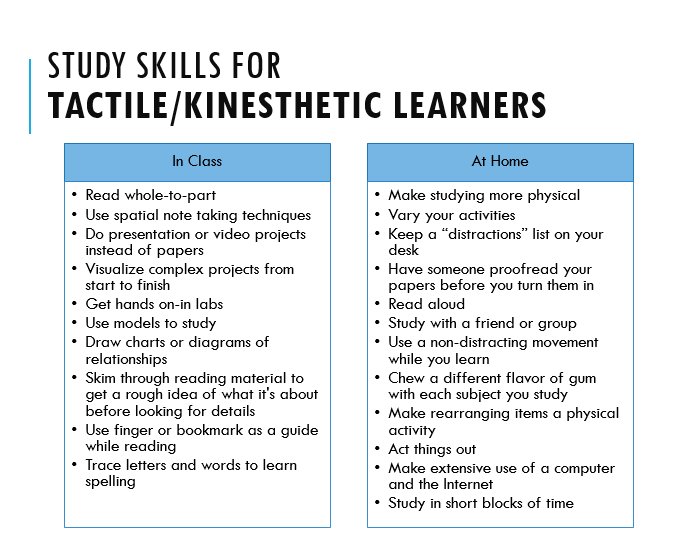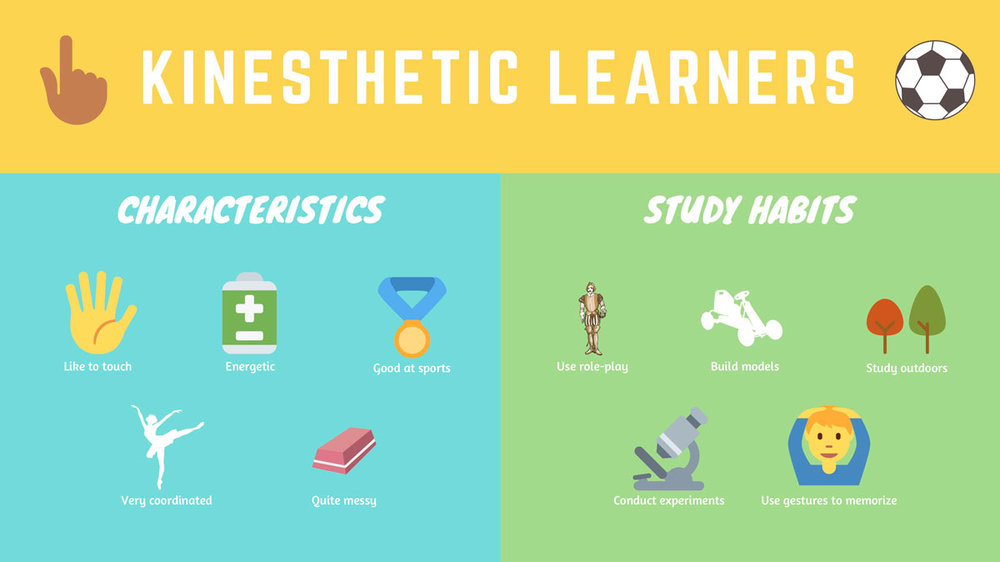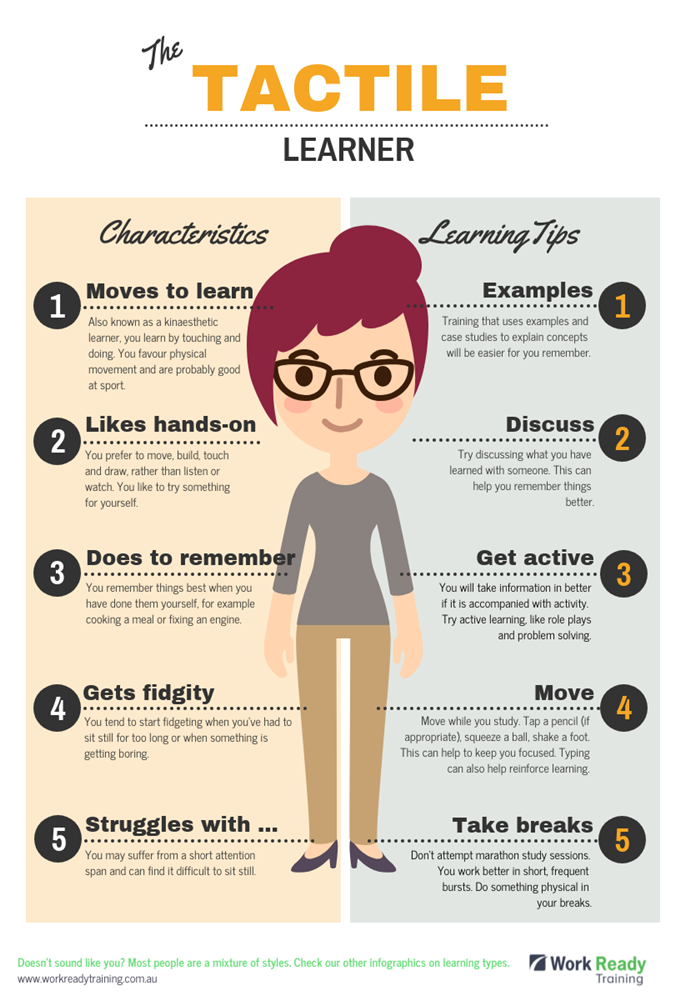You will feel tired and be less able to move energy and oxygen. If you have kinesthetic intelligence or.

Ucf Sarc On Twitter Here Are Some Helpful Study Tips For All Of You Tactile Kinesthetic Learners Out There Studytiptuesday Sarc Ucfknights Https T Co R109hk7f30 Twitter
Study works best if you.

. Role play will help almost any student learning style not just tactile. Models can be created in any subjectin math tactile. Primary Tactile learners would benefit from finding their secondary learning mode and use the directions for either Visual or Auditory in conjunction with the following hints.
Study Tips for Tactile Learners. Tactile learners usually do their best studying when movement is involved so get active as you study. As a hands-on learner it can be difficult to sit at a desk for long periods of time.
Place rocks around the room and have students walk to each station looking and touching the rocks to identify what type they are. Using flashcards to memorize. Best Ways to Study for a Visual Learner.
Spend time in the field eg. Education 8 days ago Tactile Learning Tips. When teaching science objectives you will reach tactile learners better if you plan several experiments throughout the unit to demonstrate the material.
Work out as many math problems as possible. Here are some strategies that may be useful to you are a kinesthetictactile learner. 20 Tips for Tactile Learners.
A smartpen records audio content that. Try walking around while reading or studying. Whenever possible convert what you are learning in math to real-life concrete experiences.
Using flashcards to memorize. Using a smart pen for taking notes. To engage your hands while studying you could make and use flashcards actually write out the flashcards dont use an online tool like Quizlet.
A museum historical site or job site to gain first-hand experience of your subject matter. Work with quiet music in the background. Create dioramas and models.
Kinesthetic Learners Study Tips THAT WORKThere are 4 types of learners kinesthetic verbal visual and auditory. Make games puzzles out of what you are learning. The last of the study tips for kinesthetic learners is to incorporate small breaks into your study sessions or long lectures.
Studying in short blocks of time. Rather than just sit at your desk occasionally walk back and forth with your textbook or notes as. Study Tips for the Tactile Learner High Tactile learners acquire knowledge best through manipulation - doing touching hands-on and writing techniques.
Four commonly known learning styles are. Your brain is fueled best when it has balanced nutrition. Be physically active while you study.
One tip I have for this learning type is to use your computer or even a tablet while studying. Here are 3 study tips for kinesthetic learners. Studying in short blocks of time.
Always bring a pen and a notebook at school. Think of ways to make your learning tangible ie. Take regular short breaks.
Draw to capture images of information that you are learning. High Tactile learners acquire knowledge best through manipulation - doing touching hands-on and writing techniques. Tactile learners remember where they placed things.
They need to deal with the information physically so experiments and projects are great for this type. For example try role-playing and acting out stories creating memory games or using flashcards. Close your eyes and trace words or images with your finger.
Find a Study Environment That Allows for Movement Dont Study for Long Periods of Time Take Physically Active Breaks When Studying Dont Sit Still While Studying Write and Rewrite Your Notes Visit Museums that Relate to Your Exam Topic Find a Study Group Act. Use a hands-on approach to learning. Take Frequent Breaks.
Use your hands while studying. In STEM learning particularly hands-on activities can be crucial for success. Something you can put your hands on.
Primary Tactile learners would benefit from finding their secondary learning mode and use the directions for either Visual or Auditory in conjunction with the following hints. When preparing for a test rewrite your notes into your own words. Taking field trips or visiting museums.
Using a smart pen for taking notes. If you are a tactilekinesthetic learner the suggestions that follow can help you to succeed in school to the best of your ability. Manipulate materials during hands-on activities.
For example make a model that illustrates a key concept. This means that you should plan ahead to. What are the Other Learning Styles.
Monitor their role play for factual information. Taking field trips or visiting museums. Write down as much information as possible in your class.
Study Tips for the Tactile Learner. Instead of having students watch a movie about rocks or look at pictures set up a more hands-on activity. 5 Types of Learners Study Tips for Nursing Students.
Dehydration can cause you a ton of issues. If you are a tactilekinaesthetic learner make sure you are active and use your body and sense of touch. Visual auditory tactile and kinesthetic.
People who are considered tactile learners do best by touching and doing. Spend extra time in a lab setting to learn an important procedure. Therefore every 55 minutes of studying or as often as you need take 5 minutes to walk around do some push-ups stretch or eat a snack.
Study Tips for Every Learning Style Eat Healthy Diet. Youll be amazed at the positive results.
Encouraging Kinesthetic Learners To Read And Write Activities For Kids Who Learn Best By Moving
Study Tips For Various Learning Styles The Core

The 4 Kinds Of Learners And The Best Learning Strategies For Each Bigbyte Education

Work Ready Training What S Your Learning Style Tactile Learner

What S My Learning Style Ppt Download

Getting To Know Tactile Kinaesthetic Learners Showme Images

What Learning Style Fits You Best Here Are Some Great Study Tips Kinesthetic Learners Kinesthetic Learning Kinesthetic Learning Activities Learning Techniques

The Picture Describes A Kinesthetic Learner While The Link Contains Activities To Improve Articula Kinesthetic Kinesthetic Learning Activities Tactile Learning
0 comments
Post a Comment